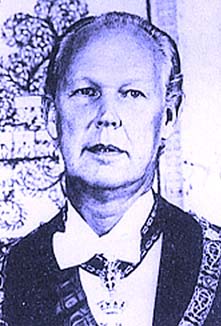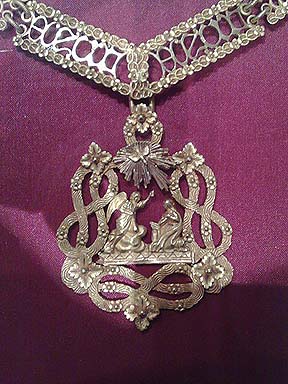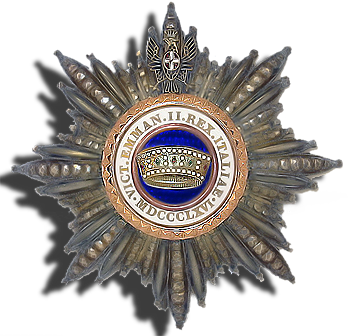
H.R.H. Crown Prince Vittorio Emmanuele
Savoia

H.R.H. Crown Prince Vittorio
Emmanuele
Grand Master of
Order of the Most
Holy Annunciation -
Established: 1362
The origins of the Supreme Order of the Most Holy Annunciation begins in
1362, when Amadeus VI, Count of Savoy (1343-1383) instituted the order's
earliest designation, under the title of Order of the Collar. Even at
this time, the order was dedicated to the Blessed Virgin Mary, who is celebrated
as "Our Lady of the Annunciation." Thus, the order is a dynastic
religious (or Catholic) order of chivalry.
Under its first formulation, the order had fifteen knights. The number was symbolic of the number of daily masses celebrated with the order. In 1409, Amadeus VIII, Duke of Savoy, gave the order its first known statutes, and in 1434, he extended the order to five more knights.
Amadeus VIII's statutes were subsequently amended and reformed by Charles III, Duke of Savoy in 1518, by Emanuele Filiberto, Duke of Savoy in 1570, and thereafter by succeeding Sovereigns. The most recent took place on 11 June 1985 by HRH Victor Emmanuel, Prince of Naples and hereditary Grand Master of the order. It was in 1518, that many of the present designations were instituted. Most importantly, the order's name was changed to its current name, The Most Holy Order of the Annunciation. The badge of the order was also changed, with the representation of the Blessed Virgin Mary being added.
The order, throughout its early history and following the reforms of Charles III, was awarded for supreme recognition of distinguished services. The order constituted a kind of religious and military fraternity between the Sovereign Head of the Order and his companions; it was reserved exclusively to distinguished men-at-arms who, apart from exemplary service, had to be of illustrious birth, particularly of catholic and noble birth.
Eventually, it was deemed appropriate to recognize also those who had rendered distinguished service to the Kingdom of Italy (and now the House of Savoy) in the exercise of high civil offices, not requiring, when a such achievements could be demonstrated, nobility of birth as well.
Former Grand Masters (after Unification):
King Vittorio Emmanuele II
King Umberto I
King Vittorio Emmanuele III
King Umberto II

Order of Saints Maurice and Lazarus - Established: The Order of Saint Lazarus was established as a military and religious community at the time of the Latin Kingdom of Jerusalem, probably some years before 1090. Presuming a foundation date of 1099 for the Order of the Hospital (now the Sovereign Military Order of Malta), the Order of Saint Lazarus is arguably the oldest surviving of the medieval military-religious knightly orders. From its inception, the order was concerned with the relief of leprosy, and many of its members were lepers who had been knights in other orders. It became very rich, its practices dubious, and its funds much abused. With the fall of Acre in 1291 the knights of St Lazarus fled the Holy Land and Egypt and settled in France and, in 1311, in Naples. In the sixteenth century, the order declined in credibility and wealth. With papal support, Duke of Savoy became Grand Master in 1572.
The Order of St Maurice was founded in 1434 by Amadeus VIII, Duke of Savoy, who became Antipope Felix V. The order declined, but in 1572 was reestablished by Pope Pius V at the instigation on the then Duke of Savoy.
Before its transfer to the House of Savoy, the Order of Saint Lazarus maintained a number of leper hospitals, prominent among these an institution in the Italian city of Capua. Though a number of French knights were reluctant to accept the Savoy grand mastership with effect in their country, the French kings ceased to bestow the Order during the eighteenth century. Scholars generally regard the international organisation known today simply as the Order of Saint Lazarus to be an illegal revival.
In 1572 Pope Gregory XIII merged the Italian foundation of the Order of Saint Lazarus with the Order of St Maurice. The new order was charged to defend the Holy See as well as continue to assist lepers. The war galleys of the order fought against the Turks and the Barbary pirates. When leprosy again broke out the order founded, in 1773, a hospital in Aosta.
With the Italian unification (1860-1871), the order became a de facto Italian state award for civilian and military merit, consisting of five classes: Knight Grand Cross, Knight Grand Officer, Knight Commander, Knight Officer and Knight.
After Italy became a republic in 1946 the order was effectively replaced by the Order of Merit of the Italian Republic. Since 1951 it has not been recognised officially by the Italian state. The House of Savoy in exile continued to bestow the order. Today it is granted to persons eminent in the public service, science, art, letters, trade, and charitable works. While the continued use of those decorations conferred prior to 1951 is permitted in Italy, the crowns on the ribbons issued before 1946 must be substituted for as many five pointed stars on military uniforms.
The generally-accepted Grand Master of the Order is Vittorio Emanuele, Prince of Naples, the current head of the House of Savoy. Some of Vittorio Emanule's policies as Grand Master have generated controversy. All three of his sisters have resigned from their positions as dames of the order. Princess Maria Gabriella of Savoy has criticised her brother for instituting "the payment of membership fees [and] activities such as the sale of objects with the Savoy coat of arms and credit cards of the order" In 2006, Vittorio Emanuele's cousin, Amedeo of Aosta, declared himself Head of the Savoy dynasty and thus Grand Master de jure. For this reason the grand magistry is now contested.
Former Grand Masters (after Unification):
King Vittorio Emmanuele II
King Umberto I
King Vittorio Emmanuele III
King Umberto II

Order of the Crown of Italy - Established: 1868 by King Vittorio Emmanuele II
The Order of the Crown of Italy was founded as a national order in 1868 by King Vittorio Emanuele II, to commemorate the unification of Italy in 1861. It was awarded in five degrees for civilian and military merit.
Compared with the older Order of Saints Maurice and Lazarus (1572), the Order of the Crown of Italy was awarded more liberally and could be conferred on non-Catholics as well; eventually, it became a requirement for a person to have already received the Order of the Crown of Italy in at least the same degree before receiving the Order of Saints Maurice and Lazarus.
The order has been suppressed by law since the foundation of the Republic in 1946. However, Umberto II did not abdicate his position as fons honorum and it remained under his Grand Mastership as a dynastic order. While the continued use of those decorations conferred prior to 1951 is permitted in Italy, the crowns on the ribbons issued before 1946 must be substituted for as many five pointed stars on military uniforms.
Former Grand Masters (after Unification):
King Vittorio Emmanuele II
King Umberto I
King Vittorio Emmanuele III
King Umberto II
